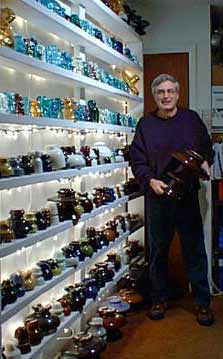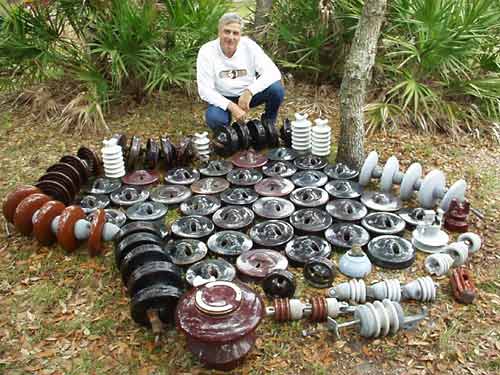
I began collecting insulators over 30 years ago. In the photograph below I am holding the first insulator that I collected which is a green glass Brookfield that I took off a pole that was blown down by Hurricane Gladys in October, 1968. That was the year I moved to Florida which resulted in both my first hurricane and my first insulator. Since then I have collected many an insulator and have experienced several hurricanes.

I have been intrigued by insulators ever since I was little boy growing up in Eastlake, Ohio in the 1940's and 50's. It began one year when a group of linemen replaced the poles in my neighborhood. I was fascinated by all the activity but most of all by the sparkling beauty of the insulators being installed. I still have that same fascination today. But, for many years I thought it must be strange of me to have such an interest and kept it a secret until that day in October, 1968, when I decided "What the heck!" I'm going to pick some of those beauties. Even though I have gathered many insulators over the years of monetary worth, their greatest value to me still remains in their beauty and the many memorable experiences I have had in collecting them. I have personally collected approximately 3 to 4 thousand insulators from throughout Florida, Ohio, and several other places. I have only paid for a handful of my insulators and have traded for dozens of them and have given away hundreds to friends, family, and charitable groups. I have many shapes, colors, brands and materials.
 Most
of my collection are American brands with a few from Canada and other countries.
Although I have travelled all the way around the world and have looked at many
foreign insulators, I rarely was in a position to gather them. One exception was
the 13 months that I spent in Southeast Asia. While in Indonesia I picked an
insulator from a pole that has a special place in my collection today.
Most
of my collection are American brands with a few from Canada and other countries.
Although I have travelled all the way around the world and have looked at many
foreign insulators, I rarely was in a position to gather them. One exception was
the 13 months that I spent in Southeast Asia. While in Indonesia I picked an
insulator from a pole that has a special place in my collection today.
My most avid attempts at collecting have been here in Florida. I went to the Florida Department of Transportation and obtained several county maps showing dirt roads and defunct railroads. I have had many wonderful experiences following the maps to great finds. I have also climbed poles in urban areas to get insulators. The first bakelite and rubber insulators I got were off of poles in St Petersburg and Tarpon Springs. Of course, I didn't know what they were until I got the first ones. From the ground they looked like unusually black glass insulators until I discovered otherwise.
The first time I waded into a swamp and climbed a pole I learned the hard way to be sure to first check the condition of a the pole below the waterline. The pole was so rotten that it broke when I got to the top ending in a hard and stunning splash. To this day I know exactly the insulator I got from that experience. It's a Hemingray spiral groove, patented October 8, 1907. I have had numerous memorable moments. Another was being chased by a wild boar and hastily climbing a pole to escape him. The worst was an encounter in 1972 with a motorcycle gang that attempted to start a fight to get a bunch of insulators that I and a friend had just gathered off of a line of poles. Fortunately, we were already in our station wagon and led them in a dusty 4 mile chase over dirt forest roads before coming to a paved highway.
 The Florida Power Company has been swapping out several of their insulators this fall and winter and I was lucky to find several in mint condition. |
Several people have contacted me through this page about collecting insulators. I have enjoyed numerous e-mails and telephone conversations and am including here what I have shared with these individuals. I am sure there are other comments and thoughts that could be added to this by other collectors. Hopefully, you will find this synopsis helpful.
Many words can be associated with the hobby of insulator collecting--history, invention, technology, communications, power, beauty, human endeavor and impact, etc. Insulator collecting is fun and leads to a lot of interesting new experiences and acquaintances. For many collectors the hobby has become very profitable. However, for most of us it is the love of the hobby that is important.
Railroad tracks are a common place to explore for insulators. As you walk the tracks be observant. Even if someone else has been there before you there may still be insulators or go-withs to be found. Take something to dig and probe with as well as something to carry and protect your discoveries. Of course, anything that is on the poles or the ground at their base will be easily seen. But, look around in the bushes and probe the ground at the base of the poles. Linemen often threw extra insulators into the bushes or the pole holes to avoid carrying them. As you walk from pole to pole keep looking around and down. It's not unusual to find insulators and go-withs between poles. If you are lucky you may even find a small dumpsite where linemen may have heaped a bunch of things. At all times be safety conscious. Be careful of weak poles, pot holes, live wires, sharp broken insulators, jagged wire, snakes, hornets, spiders, poison ivy, traffic, trains, etc.
In my early years of hunting for insulators most of it was done along old communication and power lines paralleling railroad tracks, and roads. Today, there aren't as many defunct lines to explore. But, there are other ways that I find insulators. I regularly visit maintenance yards at power and communication companies and ask permission to check their dumpsters. I have had many great finds at these yards. Often the personnel will help point out where the insulators are which isn't always in the dumpsters but on trucks, in special bins, or somewhere in a heap. I have also gathered other items at these places such as crossarms, insulator pins, and miscellaneous hardware.
As I drive, I always look for activities where lines are being maintained or replaced. Almost always linemen are willing to help and in many cases are glad to have you take the old insulators. I also trade with other collectors via the Internet or at swap meets and shows. Looking for insulators at flea markets, junk stores, antique shops is often productive and fun.
"What insulators should I collect?" is a common question from new hobbyists. You'll get different opinions from collectors. Some like to collect everything and anything. Others prefer to specialize. I have noticed that most of the new collectors tend to specialize whereas the older ones, like me, collect a variety. During the heyday of the early years when insulators were everywhere, we collected everything that was available. Today, it's more challenging to find a large variety existing in the wild. But, don't forget that there were many we overlooked or passed by because of that abundance. For me, I like variety and find it to be more interesting but I also like the many specialized collections that I have seen. As someone who loves the hobby, I respect all collections and collectors. As you begin to find and collect insulators you will develop a feeling about what direction you prefer to follow. You can learn a lot by reading insulator books, journals, newsletters, web sites, collectors' pages, and through conversations or e-mail with other collectors. This kind of research in addition to your insulator finds will help guide you. Good luck and enjoy the hobby!
|
|
I have a son and two daughters. I am retired from the Florida Department of Education where I served as the Statewide Program Director of Technology Education and also the Region 1 Director of Workforce Development. I was a tenured full professor for 11 years at Florida State University and 2 years at the University of Northern Iowa. I taught high school in Beltsville, Maryland and junior high school in Cleveland, Ohio for a few years. I have a B.S. from Miami University, M.Ed. from Ohio University, and an Ed.D. from the University of Maryland. My other interests are swimming, fishing, gardening, playing the harmonica, playing chess, shooting, airplanes, and nature.
I retired in January, 2003. I have always loved wildlife and had hoped that in my retirement I could somehow work with that interest. I applied to the Florida Wildlife Commission for a Marine Turtle Permit (MTP), served a 2 year apprenticeship, took and passed the state exam, and was issued MTP #151 to direct the Alligator Point Sea Turtle Patrol to monitor and protect sea turtles. It's has been a privileged labor of love working with sea turtles as well as the 20 dedicated and trained volunteers that help. You can follow and "like" us at http://www.facebook.com/AlligatorPointSeaTurtlePatrol
Below are a couple pictures of me with the April, 2011, issue of the "Crown Jewels of the Wire" that features my combined interest and in both insulators and sea turtles.


I would love to hear about the experiences and interests of other insulator collectors. I can be reached as follows:
Bill Wargo
Alligator Point, FL 32346
Written by Bill Wargo,
Updated Satuday, April 16, 2011